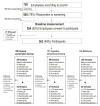Effects on musculoskeletal pain, work ability and sickness absence in a 1-year randomised controlled trial among cleaners
- PMID: 22044549
- PMCID: PMC3221640
- DOI: 10.1186/1471-2458-11-840
Effects on musculoskeletal pain, work ability and sickness absence in a 1-year randomised controlled trial among cleaners
Abstract
Background: Only a few workplace initiatives among cleaners have been reported, even though they constitute a job group in great need of health promotion. The purpose of this trial was to evaluate the effect of either physical coordination training or cognitive behavioural training on musculoskeletal pain, work ability and sickness absence among cleaners.
Methods: A cluster-randomised controlled trial was conducted among 294 female cleaners allocated to either physical coordination training (PCT), cognitive behavioural training (CBTr) or a reference group (REF). Questionnaires about musculoskeletal pain and work ability were completed at baseline and after one year's intervention. Sickness absence data were obtained from the managers' records. Analyses were performed according to the intention-to-treat-principle (ITT).
Results: No overall reduction in musculoskeletal pain, work ability or sickness absence from either PCT or CBTr compared with REF was found in conservative ITT analyses. However, explorative analyses revealed a treatment effect for musculoskeletal pain of the PCT. People with chronic neck/shoulder pain at baseline were more frequently non-chronic at follow-up after PCT compared with REF (p = 0.05).
Conclusions: The PCT intervention appeared effective for reducing chronic neck/shoulder pain among the female cleaners. It is recommended that future interventions among similar high-risk job groups focus on the implementation aspects of the interventions to maximise outcomes more distal from the intervention such as work ability and sickness absence.
Trial registration: ISRCTN: ISRCTN96241850.
Figures



References
-
- da Costa BR, Vieira ER. Risk factors for work-related musculoskeletal disorders: A systematic review of recent longitudinal studies. Am J Ind Med. 2010;11:285–323. - PubMed
Publication types
MeSH terms
Associated data
LinkOut - more resources
Full Text Sources

